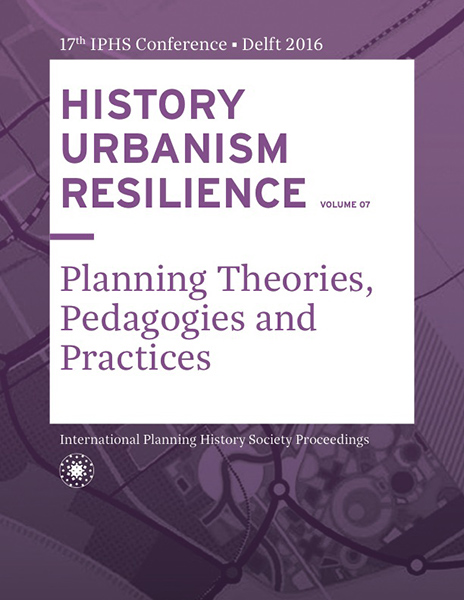Budapest of Tomorrow 1930–1960 – Continuities and discontinuities of planners’ thinking about the city throughout periods of war, reconstruction and socialism
DOI:
https://doi.org/10.7480/iphs.2016.7.1342Abstract
Preliminary works to create a General Master Plan (GMP) for Budapest had been initiated at the beginning of the 1930s, and the first City Develomment Programm as a basis for the Master Plan was approved in 1940. The first version of the GMP was elaborated until 1948, but refused by the emerging communist power. The GMP was first endorsed by the Hungarian government in 1960, after a long and tortuous struggle to adapt planners’ visions and expertise to the changing political, institutional, economic and ideological conditions and expectations. The planning process was characterized by basic continuities and discontinuities during this three decades. Continuities are reflected on personal and conceptual level: the whole period was dominated by planners committed to Modernism, some of whom were contributors from the beginning and the new key figures also built on their work and further contribution. The basic structural problems of the city – which they tried to solve, adapting internationally accepted planning principles – were chronic and permanent.This planning process offers us the possibility to explore the resilience of planners’ thinking and concepts: how did they try to adapt their plans to radical changes of the social and political environment, the ideological and cultural climate from the interwar authoritarian regime throughout the short post-war democracy to Stalinist dictatorship and early destalinization? How did they try to interpret war damages, post-war recontstruction and the eliminination of private ownership of urban land as more chances for planning a modern and well-functioning city? How did they try to adjust their plans and concepts to the requirements of the Soviet planning principles at the beginning of the 1950s? How did they experience the formally greater role of planning in the emerging „socialist planned economy”? Did the GMP really function as a blueprint for urban development?
The paper seeks to discuss these problems by highlighting a few basic questions of the professional discourse of the period: 1) The problem of spatial expansion: should the city growth be directed towards a more compact or a dispersed urban form? How centre–periphery relations should be treated? To what extent might high building be allowed or advocated? How could the region of the city be integrated into the comprehensive planning? 2) Should the city retain the inherited concentric-radial structure or should future development be organized in linear zones more adequate to the basic principles of modernist planning theories? What should be the role of river Danube which seemed to offer itself as the ideal main axis of linear zoning? 3) How different spatial units should be treated as units of social organization? Concepts about the role of neighbourhood units, residential complexes and districts. 4) Urban form and transportation: from the concept of a metropolitan railway network to the Moscow-style Metro
References
Budapest City Archives [IV.1413.x.] City Development Programme, 1940.
Budapest City Archives [IV.1420.p] Szimély Károly papers.
Budapest City Archives [XXIII.102.a. Vol. 246.] Minutes of the Executive Committee of the Capital City Council
Budapest és környéke általános rendezési terve. Budapest, 1960.
Colton J. Timothy, Moscow. Governing the Socialist Metropolis, Cambridge Mass. – London, 1995.
Diefendorf M. Jeffry, ed., Rebuilding Europe’s Bombed Cities. Basingstoke–London: Palgrave Macmillan UK, 1990.
Ferkai András, „Budapest szalagváros,” Budapesti Negyed, 18–19, (1997–1998), 143–152.
French R. Anthony, Plans, pragmatism and people. The legacy of Soviet planning for today’s cities. London: UCL Press, 1995.
Harrer Ferenc, “Budapest városfejlesztési programja,” Városi Szemle, 27 (1941) 1: 1–42.
Granasztói Pál and Polónyi Károly, Budapest holnap, Budapest: Gondolat, 1959.
Kocsis János Balázs, Városfejlesztés és városfejlődés Budapesten 1930–1985. Budapest: Gondolat, 2009.
Kőszeghy Lea, “Tömeges lakásépítés és várostervezés. A budapesti várostervezés szociológiai elemzése 1960–1975,” Urbs, Hungarian Yearbook of Urban History, 2 (2007): 293–322.
Metropolitan Ervin Szabó Library, Budapest Collection [Bf 725/629] Nagy-Budapest Általános Rendezési Terve, Építéstudományi és Tervező Intézet, 1948.
Metropolitan Ervin Szabó Library, Budapest Collection [Bq 725/6296] Budapest általános rendezési terve konzultatív bizottságának jegyzőkönyvei I-III.
Morvay Endre, “A jövő Budapestje,” Budapest 2 (1946) 1-2: 23–27., 68–72.
National Archives of Hungary, Central Archives [M-KS 276. fond 53/86. őe.]
Gábor Preisich, “A városrendezési koncepciók hatékonysága,” in A városépítésről. edited by Preisich Gábor, 468–477. Budapest: Kossuth, 1984.
Preisich Gábor, Budapest városépítésének története a Buda visszavételétől a II. világháborúig Budapest: Terc, 2004.
Sipos András, A jövő Budapestje 1930–1960. Városfejlesztési programok és rendezési tervek. Budapest: Napvilág Kiadó, 2011.
Umbrai Laura, A szociális kislakásépítés története Budapesten 1870–1948. Budapest: Napvilág Kiadó, 2008.
Vadas Ferenc, “Stadtplanung in Budapest im 19. Jahrhundert,” in Budapest und Wien. Technischer Fortschritt und urbaner Aufschwung im 19. Jahrhundert. edited by Csendes Peter and Sipos András, Budapest, Wien: Archiv der Haupstadt Budapest, Wiener Stadt- und Landesarchiv, 2003. 19–31.

